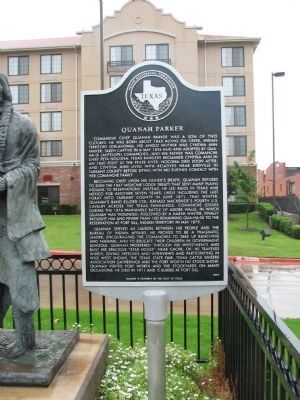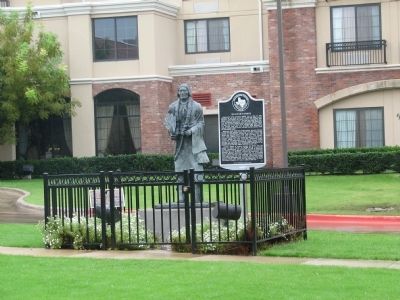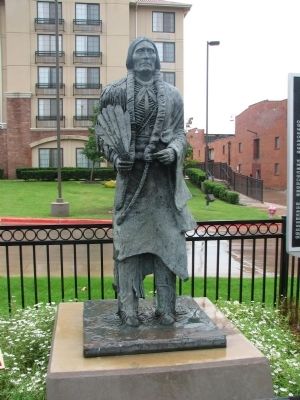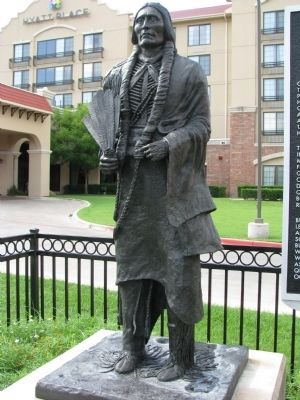Fort Worth in Tarrant County, Texas — The American South (West South Central)
Quanah Parker
Becoming chief upon his father’s death, Quanah refused to sign the 1867 Medicine Lodge Treaty that sent many Plains Indians to reservations. Instead, he led raids in Texas and Mexico for another seven years, likely including the last foray into Tarrant County in June 1871. That winter, Quanah’s band eluded Col. Ranald MacKenzie’s Fourth U.S. Cavalry across the Texas panhandle. Comanche losses during the 1874 Panhandle Battle of Adobe Walls, in which Quanah was wounded, followed by a harsh winter, finally brought him and fewer than 100 remaining Qua-Ha-Di to the reservation at Fort Sill, Indian Territory in May 1875.
Quanah served as liaison between his people and the Bureau of Indian Affairs. He proved to be a pragmatic leader, encouraging the Comanches to take up ranching and farming, and to educate their children in government schools. Quanah prospered through his investments and built his spacious “Star House” near Cache, OK. He traveled widely, giving speeches and interviews and participating in wild west shows, the Texas State Fair, Texas Cattle Raisers Association gathering and the Fort Worth Fat Stock Show. Quanah visited Fort Worth and the Stockyards on many occasions. He died in 1911 and is buried at Fort Sill.
Erected 2007 by Texas Historical Commission. (Marker Number 14005.)
Topics. This historical marker is listed in these topic lists: Agriculture • Native Americans • Settlements & Settlers • Wars, US Indian. A significant historical month for this entry is May 1836.
Location. 32° 47.301′ N, 97° 20.795′ W. Marker is in Fort Worth, Texas, in Tarrant County. Marker can be reached from East Exchange. Touch for map. Marker is at or near this postal address: 131 E Exchange, Fort Worth TX 76104, United States of America. Touch for directions.
Other nearby markers. At least 8 other markers are within walking distance of this marker. Fort Worth Stockyards Horse and Mule Barns (within shouting distance of this marker); The Fort Worth Stock Yards Company (about 300 feet away, measured in a direct line); Fort Worth Livestock Exchange (about 300 feet away); The Trailblazer (about 300 feet away); America's First Horse (about 300 feet away); Early Quarter Horse Shows (about 400 feet away); The Coliseum (about 500 feet away); The First Bulldogger (about 500 feet away). Touch for a list and map of all markers in Fort Worth.
Additional keywords. Multiracial Americans
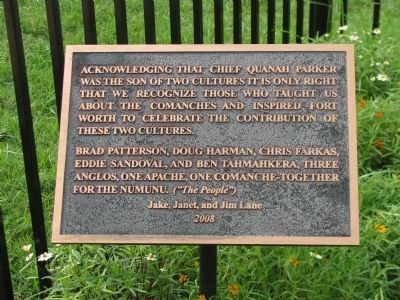
Photographed By Denise Boose, May 22, 2010
5. Quanah Parker Dedication Marker
Acknowledging that Chief Quanah Parker was the son of two cultures it is only right that we recognize those who taught us about the Comanches and inspired Fort Worth to celebrate the contribution of these two cultures.
Brad Patterson, Doug Harman, Chris Farkas, Eddie Sandoval, and Ben Tahmahkera, Three Anglos, one Apache, one Comanche-together for the Numunu. ("The People")
Jake, Janet, and Jim Lane
2008
Brad Patterson, Doug Harman, Chris Farkas, Eddie Sandoval, and Ben Tahmahkera, Three Anglos, one Apache, one Comanche-together for the Numunu. ("The People")
2008
Credits. This page was last revised on October 24, 2020. It was originally submitted on January 17, 2010, by Alan Stricklin of Fort Worth, Texas. This page has been viewed 3,078 times since then and 94 times this year. Last updated on January 26, 2010, by Alan Stricklin of Fort Worth, Texas. Photos: 1, 2, 3. submitted on January 17, 2010, by Alan Stricklin of Fort Worth, Texas. 4, 5. submitted on January 18, 2012, by Denise Boose of Tehachapi, California. • Kevin W. was the editor who published this page.
